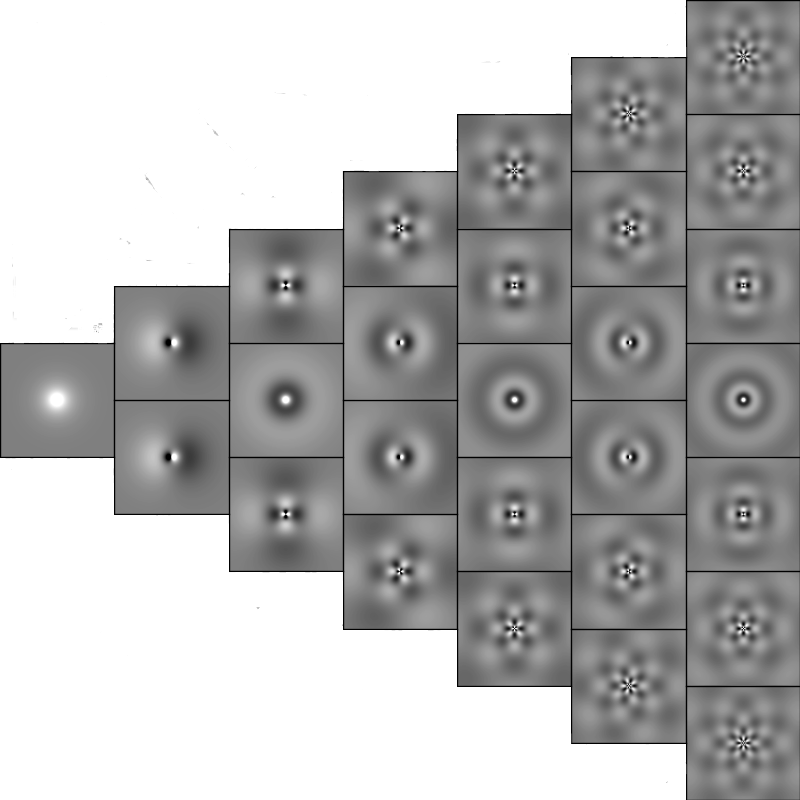Start
Research
Publications
Statistics playground
Teaching
CV
Contact
Galaxy morphologies exhibit a rich variety of shapes. In particular disc galaxies may exhibit different azimuthal structures such as spiral-arm patterns, bars, rings, warped discs, star-forming regions or dust extinction. Consequently, a highly flexible model is required in order to faithfully describe such galaxy shapes.
Linear expansion into basis functions is a very promising candidate to provide such excellent models. The idea is to decompose a given galaxy image into a handful of independent components, which later need to be interpreted.
Basis functions have a long tradition in physics and astrophysics, e.g., Fourier transforms. Also various basis functions have already been tried to parametrise galaxy morphologies, e.g., wavelets, shapelets or Chebychev polynomials.
What are the problems?
There are several important problems:
- What is a good choice of basis functions? For instance, Melchior et al. (2010) showed that shapelets suffer from serious problems.
- Does it also work in practice?
- How can we interpret the results?
- Does it also work in practice?
I showed that the Sersic profile - a radial light profile which is generally found to be a very good fit to real galaxies - is the first-order Taylor expansion of any real light profile. Consequently, the Sersic profile is no longer an empirical match, but it now has a sound justification - though a mathematical instead of astrophysical one.
 Figure 1. Example of sersiclet basis functions. Only real parts are shown here. Note that the first mode - the "ground state" - is a normal Sersic profile.
Figure 1. Example of sersiclet basis functions. Only real parts are shown here. Note that the first mode - the "ground state" - is a normal Sersic profile.
Having a well justified radial light profile, I then orthonormalised it in order to build two-dimensional polar basis functions, called sersiclets. Figure 1 shows an example how these basis functions look like. This has been tried before by Ngan et al. (2009), but they did not succeed due to technical problems.I then investigated the performance of sersiclets in practice and also tested higher-order Taylor expansions beyond the first-order Sersic profile.
Results
- The Sersic profile is not an empirical law but rather the first-order Taylor expansion of any (physically reasonable) light profile. This has several implications:
- It explains why the Sersic profile is such a good match to real data.
- When real galaxy profiles deviate from the first-order expansion, it is obvious how to enhance the Sersic profile by higher orders.
- The Sersic model parameters correspond to the Taylor expansion coefficients. If we have an astrophysical model of galaxy morphologies in the future, we can simply Taylor expand this model and thereby retrospectively assign an astrophysical interpretation to the expansion coefficents/Sersic model parameters.
- When real galaxy profiles deviate from the first-order expansion, it is obvious how to enhance the Sersic profile by higher orders.
- Orthonormalising the Sersic profile leads to polar sersiclets. These basis functions can be computed analytically, which greatly simplifies their usage.
- Unfortunately, polar sersiclets suffer from undersampling effects: As Figure 1 shows, the polar basis functions have most of their structure in the central region. This region suffers strongly from image pixellation and low resolution. Loosely speaking, polar basis functions do not appreciate being sampled on Cartesian pixel grids. In the case of sersiclets, this effect is so large that this method should not be used in practice.
- Orthonormalising higher-order Sersic profiles can overcome this undersampling problem. However, these basis functions do not exist analytically anymore, which dramatically increases the computational effort.
- It explains why the Sersic profile is such a good match to real data.